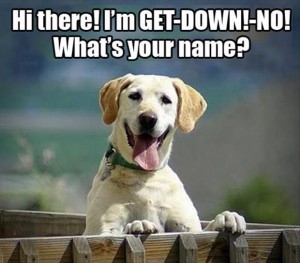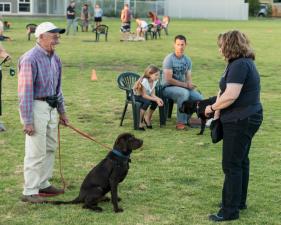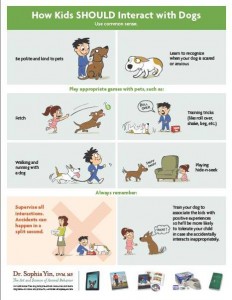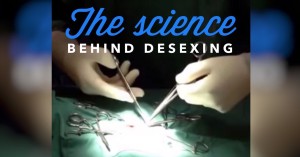If there’s one thing all vets hate it’s watching perfectly healthy, happy puppies develop behaviour problems and are rehomed or worse. Usually, the owners aren’t even sure what went wrong, and the tragic thing is that in almost every case, the cause was preventable.
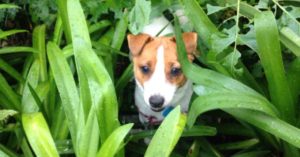
Here’s one vet’s approach to preventing and treating behaviour problems in puppies. If this is your second time, please read our guide to getting a new puppy to like an older dog.
What are the common dog behaviour problems?
- My dog bites the children
- I can’t stop my dog begging for food
- My dog keeps escaping
- The grooming salon said my dog is too aggressive
- My dog jumps up too much
- The neighbours are complaining about barking
- My dog digs or destroys things
- When I tell my dog off he growls or urinates
- When I go near my dog’s food he growls
- My dog attacks other dogs
- I can’t walk my dog on a lead
- My dog is still not toilet trained
- Visitors are afraid of my dog
Helping all these problems once they happen requires hard work plus vets, trainers and even behaviourists. We can do it, but it is much better to prevent these problems from happening in the first place. That way we have happy families and treasured pets.
How can we train puppies to be good dogs?
Our expectations of how dogs should behave have gone up over the years. More and more, we expect dogs to live with us and fit into human family structures. It’s not easy to get it right.
If you follow these simple guidelines, most puppies will grow up to be happy, well-behaved dogs. You will still have problems, and sometimes you’ll feel like it’s not working, but with kindness and persistence, your dog will learn.
Please also read our guide to reducing problems with kids and dogs in families.
Choosing your puppy
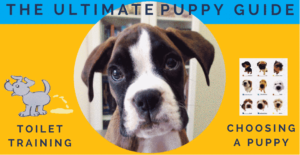
Breeds and owners need to be carefully matched, or owners need to learn the requirements of their breed. Have you already visited our Guide to choosing the right puppy for you? It contains links to other lists and resources to help your choice.
Even more basic should be the thought: “Do I have the time for a dog at all?” If you don’t have a minimum of 30 minutes for your dog per day (and a lot more for a puppy) it might not be a good idea right now.
Getting two puppies at the same time makes it harder to focus your limited time and energy on each puppy. If you wait until the first pup is trained before getting a second, you will have more time and your new pup will pick up tips from the older one.
Communication
Think about what you say to your dog, and whether they truly ‘get it’. You need to set up a system of clear communication so that your dog can know when they have done it right. Positive dog training classes and Puppy School will show you how to create a ‘Bridge’ word you can use to accurately mark good behaviour as it happens.
If you only focus on what they are doing wrong it’s difficult for them to learn; everyone’s had an employer like that. For example, try this: when your dog does something you don’t want, replace the unwanted behaviour with a behaviour that you can reward. This can work well with jumping dogs. Ignore the jump and then ask your dog for a sit. Then bridge and reward with praise or a treat.
Most people trying to discipline their dogs either accidentally reward (by giving attention) or accidentally harm (by causing fear) depending on how severe they are.
Socialisation
Is this the single most important part of raising a puppy? It may be the single most common mistake.
We give you two powerful weapons to fight for a socialised dog: Early finish vaccination programs and Puppy preschool classes.
Socialisation is a process of learning to accept and like animals, people, places, procedures and objects in your dog’s normal environment. We do it by gentle methods so that all their early experiences are positive.
Successful socialisation is the antidote to fear; dogs who don’t get to socialise with potentially fearful things before 4 months of age may always be afraid of that thing. That can include visitors, other dogs, the grooming salon or children. Read next what happens to that fear…
Understanding aggression
Fear isn’t just a bad feeling; it develops into something worse. Behaviourists say that 90% of canine aggression is fear-aggression and I think they are right. Here is an example: a puppy is afraid of other dogs, so when a dog approaches him he tries a little growl. The other dog gets the message and the fearful stimulus goes away. Now we have a rewarded behaviour. The next time the puppy is approached by a dog he will try it again. Each time he gets a further reward and the aggressive response develops.
I hope you can also see why punishing dogs for aggression is bad for the dog and bad for you. The dog that growls is highly likely to be fearful, perhaps because he expects to be punished. If he urinates or bites when punished he’s not being vindictive, he’s afraid.
Your dog isn’t trying to dominate you. Reduce aggression & fear by socialising; treat aggression & fear with gentleness and understanding.
Living with other dogs and cats
You should make any changes to your existing pet’s lifestyle well before your new puppy arrives. That way they won’t associate the changes with the puppy.
A new puppy is better accepted by an adult dog that does not feel their status is threatened. Once your puppy arrives, always treat the older dog as ‘top dog’ by giving them attention, treats and food first whenever you give them to the puppy.
Read our guides to socialising a puppy to an existing cat and getting a puppy and an older dog to get along.
For introducing to adult dogs and cats, the main points are supervision, patience and allowing them time out.
Never leave a puppy alone with another animal until you are certain things will go well 100% of the time. Avoid the puppy having access to your other pet’s food, chews or toys.
Teach your puppy independence. A puppy that always lives with another dog can quickly become dependent on that dog for their happiness. It’s great to have a friend, but not to need them. As well as lots of group outings, take your puppy for separate walks, plays and outings as well to help them be happy alone (making sure of course that the older dog gets all the same attention first).
Accepting normal puppy behaviour
All puppies get very bitey and nip a lot when they play. This is usually nothing to do with aggression, and should not cause long-term problems. To reduce play biting and nipping in puppies, do the following:
- Make no fuss; this only makes it worse. It’s a game after all
- Recognise the triggers, such as tiredness, and learn to avoid them
- Redirect your puppy onto a favourite chew toy
- Be prepared to walk away
- Do not discipline
- The behaviour will slowly wear off with age
Similarly, toilet training can be frustrating and slow in some puppies but owner frustration only makes it worse. Read our guide to toilet training for more help.
Puppies also make a game of stealing clothes and other items. Instead of chasing them (which is what they want), distract them with another toy or a treat. Or just ignore if the item isn’t dangerous or valuable. Then work out how you can reduce their access to these things.
Dog training
Fact: owners who attend dog training have a better, deeper relationship with their dog. Dog training isn’t really about getting control and it’s not just for big dogs; it’s about creating a deeper and more fulfilling relationship with your dog, whether big or small. Almost all behaviour problems are less of a problem in trained dogs.
Dogs love good dog training but all classes are not equal. My rescue dog was badly abused at a ‘dog obedience’ class, and it nearly got him euthanased.
We only recommend positive, reward-based training methods like those at the Canine Behavioural School or other positive dog trainers. These methods are effective and are the least likely to do harm. For people who don’t like the use of food rewards (which included me until I took Loki), the food can just be a training aid to speed up learning; you don’t have to do it for life.
Other methods may work but are easy to accidentally use in a way that harms the dog. All animals including humans learn better with positive reinforcement.
Nothing in life is for free
Have you heard of this? It sounds mean until you think of how you expect people to behave.
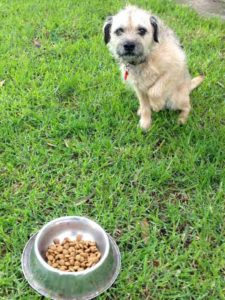
Dogs who learn to get food or attention on demand get a very unrealistic idea of their status. This can cause them to attempt to control things like laps, food or beds instead of accepting your authority.
The simplest way to exert authority is constantly and passively; nothing in life is for free’. If my kids say “give me the milk” they know it won’t come without the p-word. You need to get your dog to do the same for everything that they value from you. Every time.
The dog version of ‘please’ is a response to a command like ‘sit’ or ‘drop’. So if your dog wants a pat, or a walk, or a treat (especially if they are the one that comes asking) just ask them to do something for you first. It’s a little reminder which works because it’s done many times a day.
Furniture

How often do I hear of an owner or their child being bitten by a dog on a bed or a sofa? All the time. To a dog, these places are high status, and sitting or sleeping here is worth protecting. When little Johnny comes running up on his toddler’s legs, the dog often sees this as a threat to his position.
Many people break this rule, and when you see how happy their dogs are you understand. That’s fine as long as their dog gets down whenever asked by any family member.
I will sound mean but personally, I don’t allow my dogs on furniture at all unless I invite them onto my lap. If they growled when I put them down I wouldn’t even do this. Access to furniture makes it hard for dogs to know what’s expected of them.
Consistency
Make it easier for your puppy by starting out in the same way you will continue. It’s confusing and hard for a puppy un-learn things they learnt to do before.
It’s no good having all the right methods if you are the only one in the house doing them. If you think a rule is important for your dog’s social development, call a house meeting and explain why.
Similarly, it’s no good enforcing a rule (such as no feeding from the table) for 99% of the time and giving in every now and then. This plays right into the evolutionary drive that keeps wild dogs hunting and searching without success.
Intermittent reinforcement can be more a powerful incentive than when done continuously; a dog fed once in a blue moon from the hand will beg for it constantly. For humans, this is why poker machines are so addictive.
Children and Dogs
Read the full article at Kids & Dogs.
Children are a great source of inconsistency. Kids love dogs but have a habit of acting like puppies around them. This may be OK in a dog or breed without a hint of aggression but they will still get a lot of play bites. For some dogs however, that sort of close play can make them fail to see the children as high enough in status.
Get the kids to do the ‘nothing in life is for free’, give them supervised responsibility for feeding and get them involved with you in training classes.
Play biting can distress children; they are at just the wrong height and puppies love it when they run and squeal. Play biting will get better if it isn’t encouraged; the best thing is to stop running, divert them onto a suitable toy and either settle your puppy in their crate or leave them alone when they get silly.
Why can’t kids let sleeping dogs lie? Bothering dogs in their bed may be the number one cause of bites. If your kids can’t leave well enough alone, put your dog’s bed in a crate…
Crate training
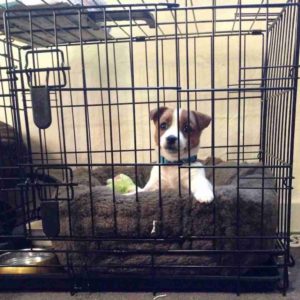
My golly, how I wish I knew about crate training with my previous dogs. What an easy run I had with Loki. Not only is Crate training great for improving Toilet training (follow the links for more advice on each) but he travels well, settles at the vet and can be confined happily whenever we need it.
Amusement
Do this thought experiment: think about which dogs in your street or suburb do the most barking. Then think about which ones you see out with their owners every day. They should be two separate groups.

Boredom may be the biggest driver for destructive behaviour, escaping and barking. Read our guide to using dog parks and off-leash areas. However, it’s clear to me that all you have to do is give them the time to explore; you don’t necessarily need to run all types of dog or tire them out. It’s the mental stimulation they need and their noses do that well.
No dog should live entirely in a yard, however big. Read the opinions of three of our vets on dog walking. Then read our article on activity toys and treat balls for their yard time.
Resource guarding
Dogs will defend anything if they value it enough. One of the most common complaints I hear about a dog’s behaviour is “he growls when I take his food away”. Hmm. What in the name of Jesse James are you doing messing with your dog’s dinner in the first place?
Many people expect their dogs to show utter servility at all times and take it as personal when their dog objects to something. This is unrealistic. Dogs love their food, and most of all, their bones. Being possessive over these is normal and you are better not to challenge them. If you do it’s probably only going to make things worse.
Here’s Cesar Millan showing you what not to do. Sigh.
Resource guarding over other more everyday items can be managed by a ‘treat exchange’ method but please, if it is getting out of hand especially around children get help early. And thank your dog when he growls at you; he’s trying to avoid conflict by warning you first.
Desexing
One of our most-read web pages is found by clicking the desexing picture. Please read it if you have the time; suffice to say that almost all important behaviour problems including roaming and aggression towards family members are improved by early desexing of male dogs.
Fencing
The way you fence your yard can influence your dog’s aggression. Dogs with access to the front fence often learn to put on territorial displays directed at passing dogs and people. Look at it from their perspective: noise approaches…I display my aggressive mojo…noise goes away = job well done.
With time this can get quite extreme and not only make your house notorious but spill over into your dog’s relationships elsewhere. They may start chasing joggers when out, or attacking dogs when the gate is left open.
The best solution is to add fencing so your dogs are kept at least 10 metres back from public areas. This is also a good idea to reduce the risk of theft. Some dogs will need to see through the fence but most will do better if they can’t see through it.
Leashes
How you restrain your dog makes a big difference to their behaviour. Neck restraint only works if the dog doesn’t pull; if they do, the neck pressure makes dogs more agitated and increases aggressive responses. Neck pressure can also damage sensitive structures such as the recurrent laryngeal nerve.
That’s why we don’t recommend walking or training dogs using neck restraints.
Head collars can work well for some dogs but others find them bothersome, and others still pull too hard. We use the Halti and Gentle Leader.
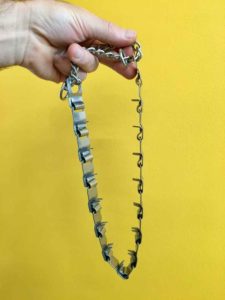
I’ve been using the Perfect Fit harness on Loki and it’s been great. He’s learned to trot along without pulling as long as no cats appear.
If you ever find a trainer using a ‘prong collar’ make a report to the RSPCA; they are illegal to import so people buy them in pieces and assemble them (legally) here. However, they are still cruel. This is the collar that caused my rescue dog to become dangerous to other dogs. Yes, he stopped pulling (who wouldn’t?) but he learnt that approaching dogs caused him pain.
and finally,
Learn dog body language
How often do I see ‘cute’ images of kids draped over dogs on Facebook. The dog is often lip-licking or yawning, has his ears down, has a stiff posture and is trying to look away from the child. The only way he could make it clearer that he’s trying not to react is a six-foot neon sign.
Reading dog body language isn’t natural to us; we have to learn it like any other skill. Once learnt you’ll see all sorts of things you never noticed before.
And in conclusion: Most of these topics (and many others) are covered better and more thoroughly in our Puppy Preschool Classes and class notes. Don’t forget, if you’re having trouble with your puppy’s or dog’s behaviour, please let us know. Sometimes we can fix it, and other times we can introduce you to people who can help. The sooner you act the easier it will be.
By Andrew Spanner BVSc(Hons) MVetStud, a vet in Adelaide, Australia. These blogs are from a series regularly posted on Facebook and Twitter. Like or follow our page on your favourite social media to read the latest.

